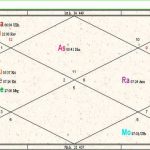The birth chart or Kundali is nothing but a snapshot of the sky at a given moment. It records the exact placement of the planets in the 360 degrees of the zodiac with other relevant details. Though the zodiac and the planetary degrees are the same, a chart can be drawn in several different formats. Most astrologers learn astrology with a particular chart format and then find it hard to decode a chart presented in any other layout. Once you understand how the chart is drawn and the logic behind the planetary placements it is very easy to obtain essential information form a chart in any format.
What Is A Birth Chart
A birth chart is a chart or drawing that sets out the 360 degrees of the zodiac. This is usually divided into houses or Rashis. The position of the planets in the zodiac is then indicated by placing them in the houses. Some charts use short forms of the planet names while others use symbols or glyphs to indicate the planets. Some astrologers write the planet degrees next to the planet while others create a table next to the chart. Retrograde planets are indicated by underlining them, placing them in brackets or with an (R) placed next to the planet. The name birth chart is misleading as a chart can be created for any moment in time for various purposes. The asking of a question or the dawn of a new year are also charts that are studied.
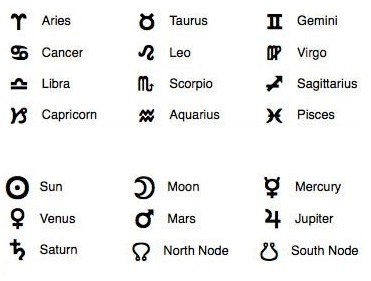
The South Indian Chart
The South Indian chart format is basically a depiction of the zodiac exactly as it is laid out. However, instead of a circle which is rather hard to draw it is depicted as a square that is divided into twelve boxes. Each of these 12 boxes is the representation of a Rashi of 30 degrees. The Rashis are always in the same boxes. To better understand the concept, imagine that the earth is at the centre of the chart and the series of boxes around it is the zodiac belt.
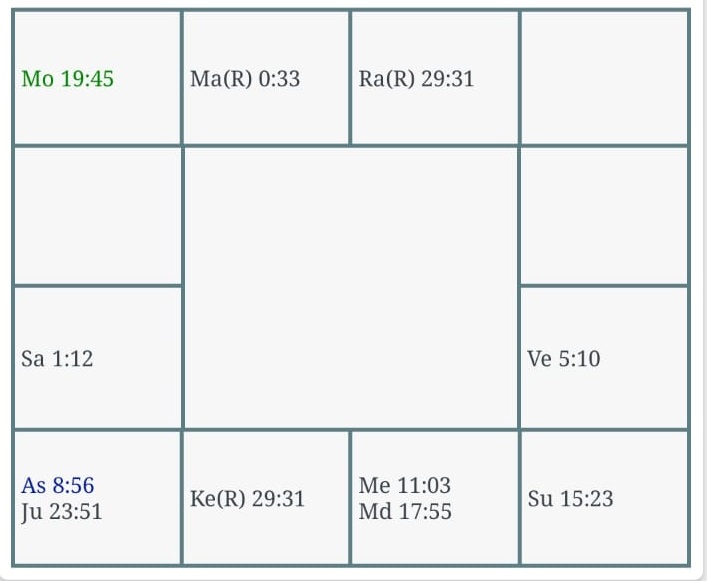
The South Indian Chart is a Rashi centric format. When the chart is filled, the planets are placed in the box that is assigned to the Rashi or sign in which it is located. The ascendant is marked in the appropriate box. It is denoted either by a slanting line or by writing Asc or Lagna in the appropriate box. One then counts the houses from the ascendant or Lagna manually. This may seem to be a cumbersome process to some but with practice and time, the astrologer is able to visualise the house numbers without counting every time.
The Advantages Of The South Indian Chart
The advantages of this chart format are that it more closely resembles the actual astronomy of the sky. It also makes it very easy to see the dignity of the planet at a glance. When one wants to shift the Lagna and view the chart from the Moon or from any other planet, there is no need to redraw or visualise the chart. One chart serves all the purposes.
People who are used to seeing aspects in other charts need to do a lot of manual counting in a South Indian chart. This too gets so much easier with practice. The counting of the South Indian chart starts from the second box in the topmost row which is always Aries (Mesha) and then proceeds in a clockwise direction of counting. There is no necessity to number any of the boxes since the Rashis are always in the same boxes and they do not need labelling. The house numbers are also easy to find by counting from the box marked Lagna/ascendant. Some people do label the house numbers for ease of use.
The South Indian chart makes it very easy to do a Rashi wise chart comparison. The two charts are studied side by side. Since the Rashis are static it is easy to see where the planet of one person is placed in relation to the planet of the other. For example, while matchmaking one can locate the Moon of the boy. Then easily count to the Moon of the girl’s chart and see how the relationship would play out.
With each Rashi in the chart allotted the same area, this chart is much easier to populate with planets. There is no odd-shaped smaller section that one has to squeeze planets into.
The North Indian Chart
The North Indian Kundali or diamond chart format is more of an astrological perspective than an astronomical one. It is a house centric chart format. Here the houses that each section denotes are static. The Rashis assigned to the sections change. So the topmost box in the chart is always the first and the lowermost is always the seventh. The advantage of the North Indian chart format is that one is able to see the Kendras and Trikonas at a glance.
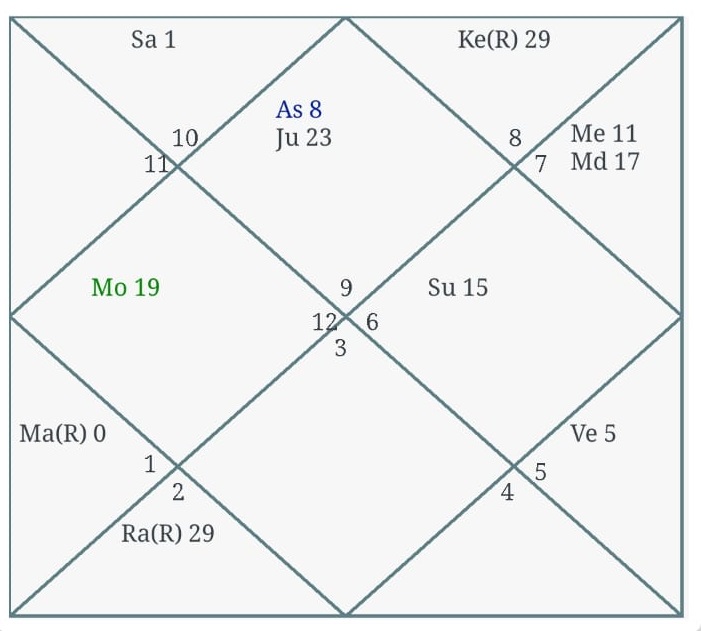
Advantages Of The North Indian Chart
The North Indian Chart always has the first house in the topmost middle diamond. The counting proceeds from 1st to 2nd house and so on in an anti-clockwise direction.
One is able to assess the house allocation of the planet at a glance. However, if one wants to present a Chandra Lagna or Moon chart the entire chart has to be redrawn. An experienced astrologer will be able to do this just by visualisation.
The North Indian chart is meaningless without numbering as the Rashi of each house cannot be determined without numbers. So, in a North Indian chart, the numbers denote the Rashis. They are numbered; Aries (Mesha) – 1, Taurus (Rishaba) – 2, Gemini (Mithuna) – 3, Cancer (Kartaka) – 4, Leo (Simha) – 5, Virgo (Kanya) – 6, Libra (Tula) – 7, Scorpio (Vrischik) – 8, Sagittarius (Dhanus) – 9, Capricorn (Makara) – 10, Aquarius (Kumbha) – 11 and Pisces (Meena) – 12.
Synastry comparison by houses is easy with the North Indian chart. However, comparison by Rashi is more difficult for the newer astrologer. The non-Kendra houses have less space in this format. If one were to have a cluster of many planets this chart would be harder to fill in neatly.
The East Indian Chart
At first glance, the East Indian chart looks like a blend of the North Indian and South Indian Charts. It is also a Rashi centric format. The centre top square is always Aries (Mesha). However, unlike the South Indian chart, the counting is anti-clockwise. The ascendant is marked in the appropriate section and house counting is done manually. The chart has the same advantages as the South Indian Chart format. It is more in line with the astronomical layout of the earth with the zodiac around it. The chart also makes it easier to see the dignity of the planets. However, house counting is difficult for the new astrologer who has to rely on manual counting from the marked ascendant.
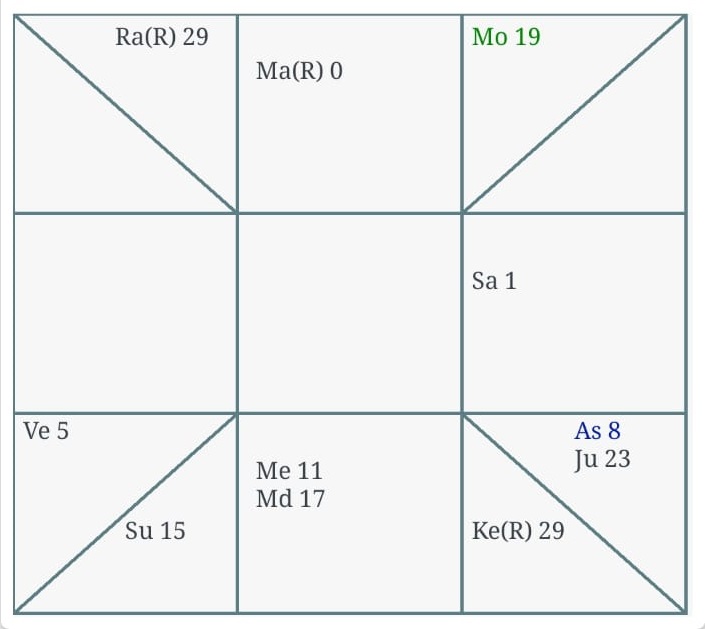
The East Indian Chart is also easier to view from different viewpoints without having to redraw the chart. There is no necessity to number any of the sections as the Rashis are static in the format. It does have awkward corner houses. These are harder to populate when there is a cluster of many planets in that Rashi.
The Western Zodiac Wheel
Western astrologers use a wheel format to represent a birth chart. This is a literal representation of the Earth with the zodiac in a circular path around it. The 360 degrees of the zodiac are divided equally into slice-like sections from the centre of the circle. The ascendant is always on the left and the Rashis follow in an anticlockwise direction. The circle of the chart has degree markings. The chart very precisely marks the planets’ placement along the circle exact to the degree. This makes it very easy to see the interplay of the planets to the exact degree. For example, in an Indian birth chart, we read the degree planets to see the strength of aspects. But in a Western chart, it is as simple as looking at the chart.
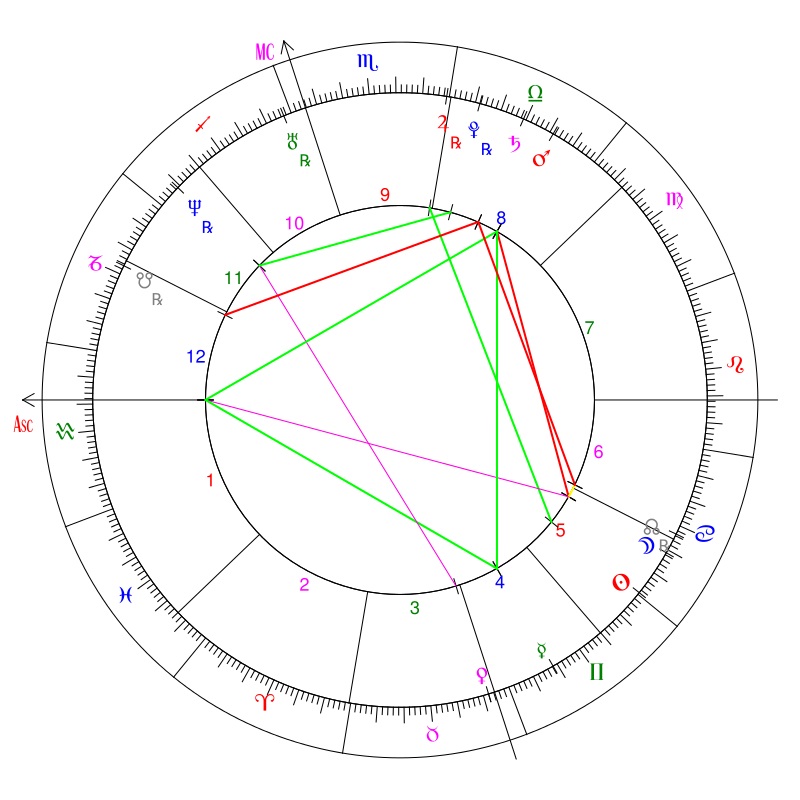
Image Source
The house divisions do not always follow the Sign divisions. The house borders could change depending on the ascendant degree. The lines that divide each house are at the cusp or junction of that house. The cusp of the first house is called the ascendant, the opposite cusp of the 7th house is the descendant. Cusp of the fourth house is the IC or Imum Coeli. The cusp of the 10th house is the MC or Medium Coeli (midheaven). Synastry or chart comparison is done by creating an inner and outer circle. The information of one chart is in the inner circle and the second chart in the outer circle in this astrology chart format.
Which Format Is The Best
The best chart depends entirely on one’s personal preferences. So, regardless of the chart format used, when one understands the logic behind each format it is very easy to decode them. Instead of being stumped when presented with an unfamiliar chart format, one can translate it to a more familiar astrology chart template. The debate of the advantages of South Indian vs North Indian chart format does not matter so much when you understand both.











